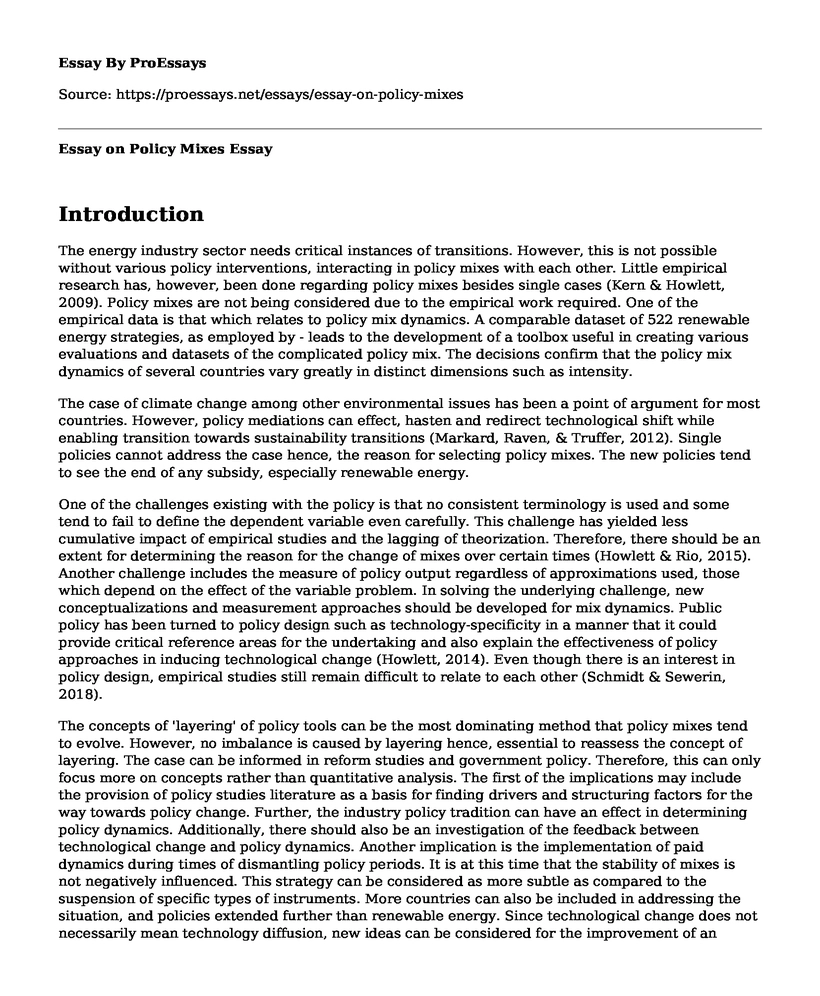Introduction
The energy industry sector needs critical instances of transitions. However, this is not possible without various policy interventions, interacting in policy mixes with each other. Little empirical research has, however, been done regarding policy mixes besides single cases (Kern & Howlett, 2009). Policy mixes are not being considered due to the empirical work required. One of the empirical data is that which relates to policy mix dynamics. A comparable dataset of 522 renewable energy strategies, as employed by - leads to the development of a toolbox useful in creating various evaluations and datasets of the complicated policy mix. The decisions confirm that the policy mix dynamics of several countries vary greatly in distinct dimensions such as intensity.
The case of climate change among other environmental issues has been a point of argument for most countries. However, policy mediations can effect, hasten and redirect technological shift while enabling transition towards sustainability transitions (Markard, Raven, & Truffer, 2012). Single policies cannot address the case hence, the reason for selecting policy mixes. The new policies tend to see the end of any subsidy, especially renewable energy.
One of the challenges existing with the policy is that no consistent terminology is used and some tend to fail to define the dependent variable even carefully. This challenge has yielded less cumulative impact of empirical studies and the lagging of theorization. Therefore, there should be an extent for determining the reason for the change of mixes over certain times (Howlett & Rio, 2015). Another challenge includes the measure of policy output regardless of approximations used, those which depend on the effect of the variable problem. In solving the underlying challenge, new conceptualizations and measurement approaches should be developed for mix dynamics. Public policy has been turned to policy design such as technology-specificity in a manner that it could provide critical reference areas for the undertaking and also explain the effectiveness of policy approaches in inducing technological change (Howlett, 2014). Even though there is an interest in policy design, empirical studies still remain difficult to relate to each other (Schmidt & Sewerin, 2018).
The concepts of 'layering' of policy tools can be the most dominating method that policy mixes tend to evolve. However, no imbalance is caused by layering hence, essential to reassess the concept of layering. The case can be informed in reform studies and government policy. Therefore, this can only focus more on concepts rather than quantitative analysis. The first of the implications may include the provision of policy studies literature as a basis for finding drivers and structuring factors for the way towards policy change. Further, the industry policy tradition can have an effect in determining policy dynamics. Additionally, there should also be an investigation of the feedback between technological change and policy dynamics. Another implication is the implementation of paid dynamics during times of dismantling policy periods. It is at this time that the stability of mixes is not negatively influenced. This strategy can be considered as more subtle as compared to the suspension of specific types of instruments. More countries can also be included in addressing the situation, and policies extended further than renewable energy. Since technological change does not necessarily mean technology diffusion, new ideas can be considered for the improvement of an understanding of the effect as caused by the design features for policy mixes. These implications can assist in surmounting the obstacle experienced in policy mix study, which is a result of the absence of empirical research in relation to policy mix dynamics.
References
Howlett, M. (2014). From the 'old' to the 'new' policy design: Design thinking beyond markets and collaborative governance. Policy Sciences, 47(3), 187-207. doi:10.1007/s11077-014-9199-0
Howlett, M., & Rio, P. D. (2015). The parameters of policy portfolios: Verticality and horizontality in design spaces and their consequences for policy mix formulation. Environment and Planning C: Government and Policy, 33(5), 1233-1245. doi:10.1177/0263774x15610059
Kern, F., & Howlett, M. (2009). Implementing transition management as policy reforms: A case study of the Dutch energy sector. Policy Sciences, 42(4), 391-408. doi:10.1007/s11077-009-9099-x
Markard, J., Raven, R., & Truffer, B. (2012). Sustainability transitions: An emerging field of research and its prospects. Research Policy, 41(6), 955-967. doi:10.1016/j.respol.2012.02.013
Schmidt, T. S., & Sewerin, S. (2018). Measuring the temporal dynamics of policy mixes - An empirical analysis of renewable energy policy mixes' balance and design features in nine countries. Research Policy. doi:10.1016/j.respol.2018.03.012
Cite this page
Essay on Policy Mixes. (2022, May 22). Retrieved from https://proessays.net/essays/essay-on-policy-mixes
If you are the original author of this essay and no longer wish to have it published on the ProEssays website, please click below to request its removal:
- What Can Christianity Contribute to Pluralistic Culture? Essay Example
- Research Paper on Democracy and Dictatorship
- Paper Example on National Party Committees
- Essay Sample on Japanese Internment: Nasty, Brutish, and Unpleasant
- Essay on U.S. War on Drugs: Unsuccessful Campaigns, Drug Control, and Military Aid
- Essay Example on White Australia Policy: Immigration Restriction Act 1901
- 74 People Selected in 82-Year History to Serve on Federal Reserve Board - Paper Example







